
Sir Alfred Joseph Hitchcock was an English film director. He is widely regarded as one of the most influential figures in the history of cinema. In a career spanning six decades, he directed over 50 feature films, many of which are still widely watched and studied today. Known as the "Master of Suspense", Hitchcock became as well known as any of his actors thanks to his many interviews, his cameo appearances in most of his films, and his hosting and producing the television anthology Alfred Hitchcock Presents (1955–65). His films garnered 46 Academy Award nominations, including six wins, although he never won the award for Best Director, despite five nominations.

Psycho is a 1960 American horror film produced and directed by Alfred Hitchcock. The screenplay, written by Joseph Stefano, was based on the 1959 novel of the same name by Robert Bloch. The film stars Anthony Perkins, Janet Leigh, Vera Miles, John Gavin, and Martin Balsam. The plot centers on an encounter between on-the-run embezzler Marion Crane (Leigh) and shy motel proprietor Norman Bates (Perkins) and its aftermath, in which a private investigator (Balsam), Marion's lover Sam Loomis (Gavin), and her sister Lila (Miles) investigate her disappearance.

The spy film, also known as the spy thriller, is a genre of film that deals with the subject of fictional espionage, either in a realistic way or as a basis for fantasy. Many novels in the spy fiction genre have been adapted as films, including works by John Buchan, le Carré, Ian Fleming (Bond) and Len Deighton. It is a significant aspect of British cinema, with leading British directors such as Alfred Hitchcock and Carol Reed making notable contributions and many films set in the British Secret Service.
In fiction, a MacGuffin is an object, device, or event that is necessary to the plot and the motivation of the characters, but insignificant, unimportant, or irrelevant in itself. The term was originated by Angus MacPhail for film, adopted by Alfred Hitchcock, and later extended to a similar device in other fiction.

North by Northwest is a 1959 American spy thriller film produced and directed by Alfred Hitchcock, and starring Cary Grant, Eva Marie Saint, and James Mason. The screenplay was by Ernest Lehman, who wanted to write "the Hitchcock picture to end all Hitchcock pictures".
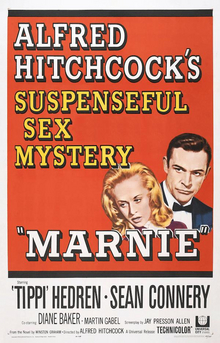
Marnie is a 1964 American psychological thriller film directed by Alfred Hitchcock from a screenplay by Jay Presson Allen, based on the 1961 novel of the same name by Winston Graham. The film stars Tippi Hedren and Sean Connery.

The International Style or internationalism is a major architectural style that developed in the 1920s and 1930s and was closely related to modernism and modernist architecture. It was first defined by Museum of Modern Art (MoMA) curators Henry-Russell Hitchcock and Philip Johnson in 1932, based on works of architecture from the 1920s. The terms rationalist architecture and modern movement are often used interchangeably with International Style, although the former is mostly used in the English-speaking world to specifically refer to the Italian rationalism, or even the International Style that developed in Europe as a whole.

Modern architecture, also called modernist architecture, was an architectural movement and style that was prominent in the 20th century, between the earlier Art Deco and later postmodern movements. Modern architecture was based upon new and innovative technologies of construction ; the principle functionalism ; an embrace of minimalism; and a rejection of ornament.
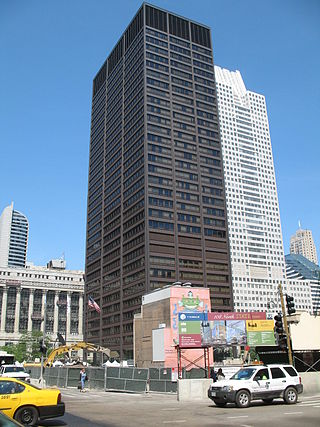
The Richard J. Daley Center, also known by its open courtyard Daley Plaza and named after longtime mayor Richard J. Daley, is the premier civic center of the City of Chicago in Illinois. The Center's modernist skyscraper primarily houses offices and courtrooms for the Cook County Circuit Courts, Cook County State's Attorney and additional office space for the City and the County. It is adjacent to the neoclassical City Hall-County Building, also on the plaza. The open granite-paved plaza used for gatherings, protests, and events is also the site of the Chicago Picasso, a gift to the city from the artist.

A matte painting is a painted representation of a landscape, set, or distant location that allows filmmakers to create the illusion of an environment that is not present at the filming location. Historically, matte painters and film technicians have used various techniques to combine a matte-painted image with live-action footage (compositing). At its best, depending on the skill levels of the artists and technicians, the effect is seamless and creates environments that would otherwise be impossible or expensive to film. In the scenes, the painting part is static while movements are integrated on it.
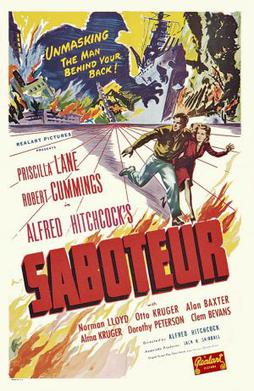
Saboteur is a 1942 American spy thriller film directed by Alfred Hitchcock with a screenplay written by Peter Viertel, Joan Harrison and Dorothy Parker. The film stars Robert Cummings, Priscilla Lane and Norman Lloyd.

The 39 Steps is a 1935 British spy thriller film directed by Alfred Hitchcock, starring Robert Donat and Madeleine Carroll. It is loosely based on the 1915 novel The Thirty-Nine Steps by John Buchan. It concerns a Canadian civilian in London, Richard Hannay, who becomes caught up in preventing an organisation of spies called "The 39 Steps" from stealing British military secrets. Mistakenly accused of the murder of a counter-espionage agent, Hannay goes on the run to Scotland and becomes tangled up with an attractive woman, Pamela, while hoping to stop the spy ring and clear his name.
The Alice Davis Hitchcock Book Award, established in 1949, by the Society of Architectural Historians, annually recognizes "the most distinguished work of scholarship in the history of architecture published by a North American scholar." The oldest of the six different publication awards given annually by the Society, it is named after the mother of architectural historian Henry-Russell Hitchcock.
Leslie Robert BurksA.S.C. was an American cinematographer who worked in many different film genres and collaborated several times with Alfred Hitchcock.
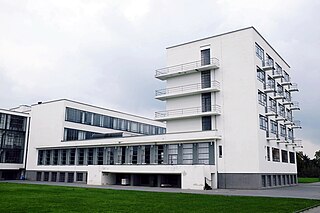
The New Objectivity is a name often given to the Modern architecture that emerged in Europe, primarily German-speaking Europe, in the 1920s and 30s. It is also frequently called Neues Bauen. The New Objectivity remodeled many German cities in this period.
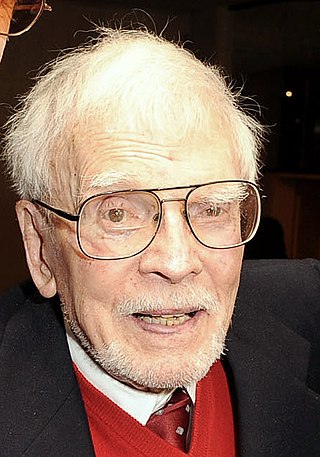
Robert Francis Boyle was an American film art director and production designer. He was nominated for four Academy Awards for North by Northwest (1959), Gaily, Gaily (1969), Fiddler on the Roof (1971), and The Shootist (1976), before winning the Honorary Academy Award in 2008. He was also nominated for a Primetime Emmy Award for The Red Pony (1973).

Rope is a 1948 American psychological crime thriller film directed by Alfred Hitchcock, based on the 1929 play of the same name by Patrick Hamilton. The film was adapted by Hume Cronyn with a screenplay by Arthur Laurents.
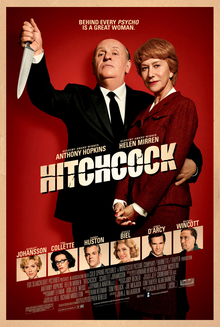
Hitchcock is a 2012 American biographical romantic drama film directed by Sacha Gervasi and based on Stephen Rebello's 1990 non-fiction book Alfred Hitchcock and the Making of Psycho. Hitchcock tells the story of the relationship between Alfred Hitchcock and his wife, Alma Reville, during the filming of Psycho in 1959. Hitchcock premiered at the AFI Fest on November 1, 2012 and was released in the United States on November 23 by Fox Searchlight Pictures. It grossed $27 million against a $15 million budget.
A one-shot film is a full-length movie filmed in one long take by a single camera, or manufactured to give the impression it was.

Spokane and its neighborhoods contain a patchwork of architectural styles that give them a distinct identity and illustrate the changes throughout the city's history. Spokane has a rich architectural history for a western city of its size and much of it is a product of its circumstances at the turn of the 20th century when as a rapidly growing city, the Great Fire of 1889 destroyed 32 blocks of the city center which was quickly rebuilt in a more grand fashion by a community flush with money coming from regional mining districts. Many of the architects that found work in the city and building on the blank slate of the downtown commercial district became highly esteemed architects such as Kirtland Cutter, who has been credited with giving the city a distinctive character. In particular, the city has a high concentration of Romanesque Revival style institutional and commercial buildings and American Craftsman bungalow residences. The architecture of Spokane gained national recognition in industry publications in the early 20th century.
















